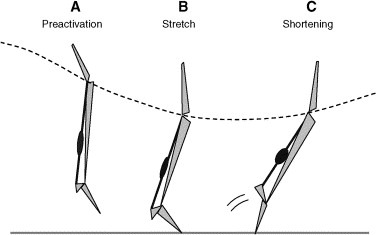
It has been demonstrated that most of the strength gains during weight lifting is due to the eccentric portion of the movement. Besides, the shortening contractions of leg muscles used to run up flights of stairs result in far less soreness than the lengthening contractions used for running down. These phenomena have to do with the physiological mechanisms behind muscle fibers' contraction. During a lengthening contraction, the load pulls the actin and myosin cross-bridges while they are still bound and this appears to require more energy expenditure than in the shortening or isometric muscle activation.
Another well known phenomenon related to the effect of eccentric contraction on the muscle performance is the Stretch Shortening Cycle (SSC):
It has been postulated that elastic structures in series with the contractile component can store energy like a spring after being forcibly stretched. Since the length of the tendon increases due to the active stretch phase, if the series elastic component acts as a spring, it would therefore be storing more potential energy. This energy would be released as the tendon shortened.
A very interesting article on the use of plyometric training for distance running is posted in this wonderful website www.kinetic-revolution.com by James Dunne and Neil Scholes.
No comments:
Post a Comment